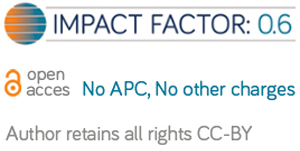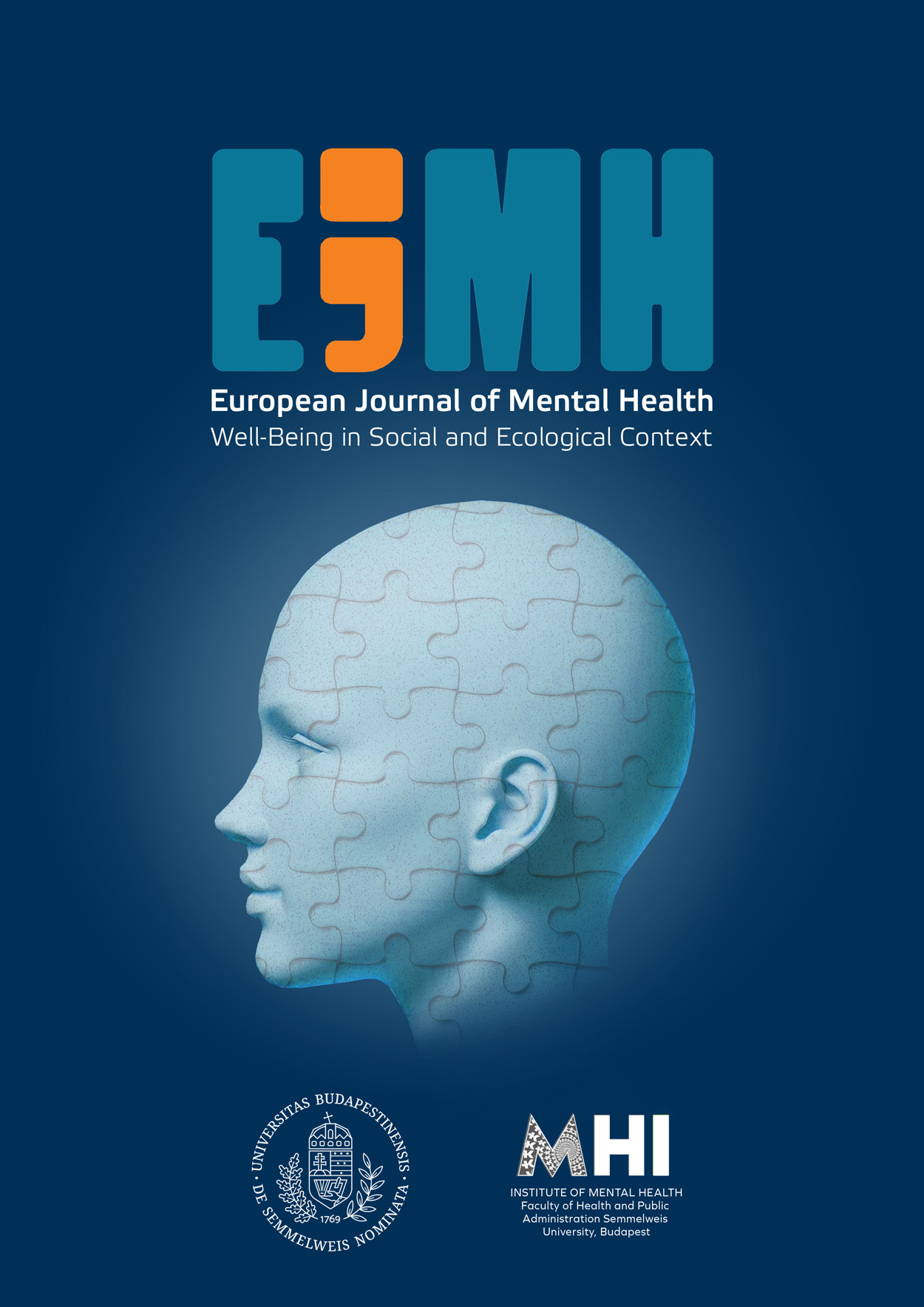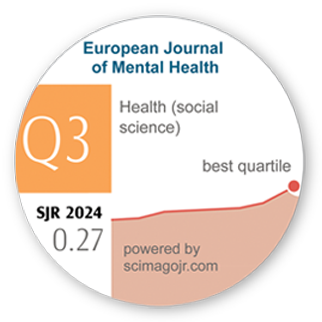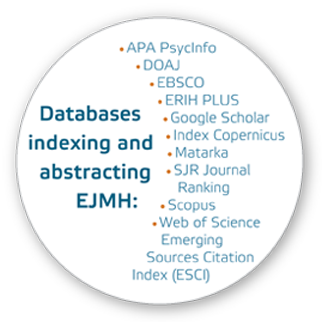Psychometric Properties of the Hungarian UCLA Loneliness Scale Among Adolescents: A Search for the Meaning of Loneliness in the Young Population
DOI:
https://doi.org/10.5708/EJMH.19.2024.0034Keywords:
loneliness, adolescence, validity, reliability, UCLA Loneliness ScaleAbstract
Introduction: Loneliness has been considered a major public health and policy concern, with substantial physical and mental health impacts. The University of California and Los Angeles Loneliness Scale (UCLA-LS) is one of the most widely used scales for measuring loneliness but it does not have robust psychometric properties among adolescents.
Aims: To evaluate the psychometric properties of the Hungarian UCLA-LS among adolescents.
Methods: The sample includes a total of 2508 students, 57.3% females, aged between 14 and 21 years. Studying psychometric properties, internal reliability and criterion-related validity were measured. The sample was randomly divided into two parts to examine the factorial structure: one part was used for exploratory factor analysis (EFA) and the other was used for confirmatory factor analysis (CFA).
Results: The UCLA-LS showed good internal consistency. Its total score and the single-item measure showed a small correlation, and also indicated a significant moderate association with hopelessness and self-reported well-being. Based on the EFA, we identified two factors with 51.7% of the total variance explained. In the CFA, the two-factor model demonstrated a good fit.
Conclusions: The findings suggested that the Hungarian UCLA-LS can be a reliable and valid tool for adolescents to measure some dimensions of loneliness. We confirmed the non-normal, relatively skewed distribution of the scale. We can conclude that the UCLA-LS measures a trait characteristic of loneliness. In the adolescent population, it is recommended to use further measures of loneliness to gain more information about the frequency and nature of the multi-faceted mental representation of loneliness.
References
Adams, G. R., Openshaw, D. K., Bennion, L., Mills, T., & Noble, S. (1988). Loneliness in late adolescence: A social skills training study. Journal of Adolescent Research, 3(1), 81–96.
https://doi.org/10.1177/074355488831007
Austin, B. A. (1983). Factorial structure of the UCLA Loneliness Scale. Psychological Reports, 53(3), 883–889.
https://doi.org/10.2466/pr0.1983.53.3.883
Bandalos, D. L., & Finney, S. J. (2010). Factor analysis: Exploratory and confirmatory. In G. R. Hancock, L. M. Stapleton, & R. O. Mueller (Eds.), The reviewer's guide to quantitative methods in the social sciences (pp. 93–114). Routledge.
Bangee, M., & Qualter, P. (2018). Examining the visual processing patterns of lonely adults. Scandinavian Journal of Psychology, 59(4), 351–359.
https://doi.org/10.1111/sjop.12436
Barreto, M., Victor, C., Hammond, C., Eccles, A., Richins, M. T., & Qualter, P. (2021). Loneliness around the world: Age, gender, and cultural differences in loneliness. Personality and Individual Differences, 169, Article 110066.
https://doi.org/10.1016/j.paid.2020.110066
Beck, A. T., Weissman, A., Lester, D., & Trexler, L. (1974). The measurement of pessimism: the hopelessness scale. Journal of Consulting and Clinical Psychology, 42(6), 861–865.
https://doi.org/10.1037/h0037562
Beck, A. T., & Steer, R. A. (1988). Manual for the Beck Hopelessness Scale. San Antonio, TX: Psychological Corp.
Boffo, M., Mannarini, S., & Munari, C. (2012). Exploratory structure equation modeling of the UCLA Loneliness Scale: A contribution to the Italian adaptation. TPM-Testing, Psychometrics, Methodology in Applied Psychology, 19(4), 345–363.
Cacioppo, J., & Patrick, W. (2008). Loneliness: Human nature and the need for social connection. W.W. Norton & Company.
Cacioppo, J. T., Hawkley, L. C., & Berntson, G. G. (2003). The anatomy of loneliness. Current Directions in Psychological Science, 12(3), 71–74.
https://doi.org/10.1111/1467-8721.01232
Cacioppo, J. T., Hawkley, L. C., & Thisted, R. A. (2010). Perceived social isolation makes me sad: 5-year cross-lagged analyses of loneliness and depressive symptomatology in the Chicago Health, Aging, and Social Relations Study. Psychology and Aging, 25(2), 453–463.
https://doi.org/10.1037/a0017216
Cole, A., Bond, C., Qualter, P., & Maes, M. (2021). A systematic review of the development and psychometric properties of loneliness measures for children and adolescents. International Journal of Environmental Research and Public Health, 18(6), Article 3285.
https://doi.org/10.3390/ijerph18063285
Csóka, Sz., Szabó, G., Sáfrány, E., Rochlitz, R., & Bódizs, R. (2007). Kísérlet a felnőttkori kötődés mérésére – A Kapcsolati Kérdőív (Relationship Scale Questionnaire) magyar változata [An attempt to measure adult attachment - the Hungarian version of the Relationship Scale Questionnaire]. Pszichológia, 27(4), 333–355.
Dussault, M., Fernet, C., Austin, S., & Leroux, M. (2009). Revisiting the factorial validity of the Revised UCLA Loneliness Scale: A test of competing models in a sample of teachers. Psychological Reports, 105(3), 849–856.
https://doi.org/10.2466/PR0.105.3.849-856
Ernst, M., Niederer, D., Werner, A. M., Czaja, S. J., Mikton, C., Ong, A. D., Rosen, T., Brähler, E., & Beutel, M. E. (2022). Loneliness before and during the COVID-19 pandemic: A systematic review with meta-analysis. The American Psychologist, 77(5), 660–677.
https://doi.org/10.1037/amp0001005
Franssen, T., Stijnen, M., Hamers, F., & Schneider, F. (2020). Age differences in demographic, social and health-related factors associated with loneliness across the adult life span (19–65 years): A cross-sectional study in the Netherlands. BMC Public Health, 20(1), Article 1118.
https://doi.org/10.1186/s12889-020-09208-0
Hartshorne, T. S. (1993). Psychometric properties and confirmatory factor analysis of the UCLA Loneliness Scale. Journal of Personality Assessment, 61(1), 182–195.
https://doi.org/10.1207/s15327752jpa6101_14
Hawkley, L. C., Browne, M. W., & Cacioppo, J. T. (2005). How can I connect with thee? Let me count the ways. Psychological Science, 16(10), 798–804.
https://doi.org/10.1111/j.1467-9280.2005.01617.x
Hawkley, L. C., & Cacioppo, J. T. (2010). Loneliness matters: A theoretical and empirical review of consequences and mechanisms. Annals of Behavioral Medicine: A publication of the Society of Behavioral Medicine, 40(2), 218–227.
https://doi.org/10.1007/s12160-010-9210-8
Hu, L-T., & Bentler, P. M. (1999). Cutoff criteria for fit indices in covariance structure analysis: Conventional criteria versus new alternatives. Structural Equation Modeling, 6(1), 1–55.
https://doi.org/10.1080/10705519909540118
Jones, W. H., Carpenter, B. N., & Quintana, D. (1985). Personality and interpersonal predictors of loneliness in two cultures. Journal of Personality and Social Psychology, 48(6), 1503–1511.
https://doi.org/10.1037/0022-3514.48.6.1503
Kline, R. B. (2011). Principles and practice of structural equation modelling (3rd ed.). Guilford Press.
Ladd, G. W., & Ettekal, I. (2013). Peer-related loneliness across early to late adolescence: Normative trends, intra-individual trajectories, and links with depressive symptoms. Journal of Adolescence, 36(6), 1269–1282.
https://doi.org/10.1016/j.adolescence.2013.05.004
Lasgaard, M., Friis, K., & Shevlin, M. (2016). "Where are all the lonely people?" A population-based study of high-risk groups across the life span. Social Psychiatry and Psychiatric Epidemiology, 51(10), 1373–1384.
https://doi.org/10.1007/s00127-016-1279-3
Lasgaard, M., Goossens, L., Bramsen, R. H., Trillingsgaard, T., & Elklit, A. (2011). Different sources of loneliness are associated with different forms of psychopathology in adolescence. Journal of Research in Personality, 45(2), 233–237.
https://doi.org/10.1016/j.jrp.2010.12.005
Lee, Y., & Ko, Y. (2018). Feeling lonely when not socially isolated: Social isolation moderates the association between loneliness and daily social interaction. Journal of Social and Personal Relationships, 35(10), 1340–1355.
https://doi.org/10.1177/0265407517712902
Lim, M. H., Eres, R., & Vasan, S. (2020). Understanding loneliness in the twenty-first century: an update on correlates, risk factors, and potential solutions. Social Psychiatry and Psychiatric Epidemiology, 55(7), 793–810.
https://doi.org/10.1007/s00127-020-01889-7
Lyyra, N., Thorsteinsson, E. B., Eriksson, C., Madsen, K. R., Tolvanen, A., Löfstedt, P., & Välimaa, R. (2021). The association between loneliness, mental well-being, and self-esteem among adolescents in four Nordic countries. International Journal of Environmental Research and Public Health, 18(14), Article 7405.
https://doi.org/10.3390/ijerph18147405
MacCallum, R. C., Browne, M. W., & Sugawara, H. M. (1996). Power analysis and determination of sample size for covariance structure modeling. Psychological Methods, 1(2), 130–149.
https://doi.org/10.1037/1082-989X.1.2.130
Maes, M., Qualter, P., Vanhalst, J., Van den Noortgate, W., & Goossens, L. (2019). Gender differences in loneliness across the lifespan: A meta‐analysis. European Journal of Personality, 33(6), 642–654.
https://doi.org/10.1002/per.2220
Mahon, N. E., & Yarcheski, A. (1990). The dimensionality of the UCLA Loneliness Scale in early adolescents. Research in Nursing & Health, 13(1), 45–52.
https://doi.org/10.1002/nur.4770130108
Mahon, N. E., Yarcheski, T. J., & Yarcheski, A. (1995). Validation of the revised UCLA Loneliness Scale for adolescents. Research in Nursing & Health, 18(3), 263–270.
https://doi.org/10.1002/nur.4770180309
Matthews, T., Fisher, H. L., Bryan, B. T., Danese, A., Moffitt, T. E., Qualter, P., Verity, L., & Arseneault, L. (2022). This is what loneliness looks like: A mixed-methods study of loneliness in adolescence and young adulthood. International Journal of Behavioral Development, 46(1), 18–27.
https://doi.org/10.1177/0165025420979357
McWhirter, B. T. (1990). Factor analysis of the Revised UCLA Loneliness Scale. Current Psychology: A Journal for Diverse Perspectives on Diverse Psychological Issues, 9(1), 56–68.
https://doi.org/10.1007/BF02686768
Mund, M., & Neyer, F. J. (2019). Loneliness effects on personality. International Journal of Behavioral Development, 43(2), 136–146.
https://doi.org/10.1177/0165025418800224
Nicolaisen, M., & Thorsen, K. (2014). Who are lonely? Loneliness in different age groups (18–81 years old), using two measures of loneliness. International Journal of Aging & Human Development, 78(3), 229–257.
https://doi.org/10.2190/AG.78.3.b
Peplau, L. A., & Perman, D. (1979). Blueprint for a social psychological theory of loneliness. In M. Cook & G. Wilson (Eds.), Love and attraction: An international conference (pp. 101–110). Oxford: Pergamon.
Peplau, L. A. (1985). Loneliness research: Basic concepts and findings. In I. G. Sarason & B. R. Sarason (Eds.), Social support: Theory, research and applications (pp. 269–286). NATO ASI Series, Vol 24. Springer, Dordrecht.
https://doi.org/10.1007/978-94-009-5115-0_15
Perczel-Forintos, D., Sallai, J., & Rózsa, S. (2001). A Beck-féle Reménytelenség Skála pszichometriai vizsgálata [Psychometric properties of Beck Hopelessness Scale]. Psychiatria Hungarica, 16(6), 632–43.
Qualter, P., Vanhalst, J., Harris, R., Van Roekel, E., Lodder, G., Bangee, M., Maes, M., & Verhagen, M. (2015). Loneliness across the life span. Perspectives on Psychological Science: A journal of the Association for Psychological Science, 10(2), 250–264.
https://doi.org/10.1177/1745691615568999
Russell, D., Peplau, L. A., & Ferguson, M. L. (1978). Developing a measure of loneliness. Journal of Personality Assessment, 42(3), 290–294.
https://doi.org/10.1207/s15327752jpa4203_11
Russell, D., Peplau, L. A., & Cutrona, C. E. (1980). The revised UCLA Loneliness Scale: Concurrent and discriminant validity evidence. Journal of Personality and Social Psychology, 39(3), 472–480.
https://doi.org/10.1037//0022-3514.39.3.472
Russell, D. (1982). The measurement of loneliness. In L. Peplau, & D. Perlman (Eds.), Loneliness: A sourcebook of current theory, research and therapy (pp.81–104). Wiley Interscience.
Russell D. W. (1996). UCLA Loneliness Scale (Version 3): Reliability, validity, and factor structure. Journal of Personality Assessment, 66(1), 20–40.
https://doi.org/10.1207/s15327752jpa6601_2
Schreiber, J. B., Nora, A., Stage, F. K., Barlow, E. A., & King, J. (2006). Reporting structural equation modeling and confirmatory factor analysis results: A review. The Journal of Educational Research, 99(6), 323–338.
https://doi.org/10.3200/JOER.99.6.323-338
Sisenwein, R. J. (1964). Loneliness and the individual as viewed by himself and others (Publication No. 6504768) [Doctoral dissertation, Columbia University, Teachers Collage]. ProQuest Dissertations Publishing.
Spithoven, A. W. M., Bijttebier, P., & Goossens, L. (2017). It is all in their mind: A review on information processing bias in lonely individuals. Clinical Psychology Review, 58, 97–114.
https://doi.org/10.1016/j.cpr.2017.10.003
Surkalim, D. L., Luo, M., Eres, R., Gebel, K., van Buskirk, J., Bauman, A., & Ding, D. (2022). The prevalence of loneliness across 113 countries: Systematic review and meta-analysis. BMJ, 376, Article e067068.
https://doi.org/10.1136/bmj-2021-067068
Vanhalst, J., Goossens, L., Luyckx, K., Scholte, R. H., & Engels, R. C. (2013). The development of loneliness from mid- to late adolescence: Trajectory classes, personality traits, and psychosocial functioning. Journal of Adolescence, 36(6), 1305–1312.
https://doi.org/10.1016/j.adolescence.2012.04.002
van Roekel, E., Goossens, L., Verhagen, M., Wouters, S., Engels, R. C. M. E., & Scholte, R. H. J. (2013). Loneliness, affect, and adolescents’ appraisals of company: An experience sampling method (ESM) study. Journal of Research on Adolescence, 24(2), 350–363.
https://doi.org/10.1111/jora.12061
van Roekel, E., Verhagen, M., Engels, R. C. M. E., Scholte, R. H. J., Cacioppo, S., & Cacioppo, J. T. (2018). Trait and state levels of loneliness in early and late adolescents: Examining the differential reactivity hypothesis. Journal of Clinical Child and Adolescent Psychology, 47(6), 888–899.
https://doi.org/10.1080/15374416.2016.1146993
Wilson, D., Cutts, J., Lees, I., Mapungwana, S., & Maunganidze, L. (1992). Psychometric properties of the revised UCLA Loneliness Scale and two short-form measures of loneliness in Zimbabwe. Journal of Personality Assessment, 59(1), 72–81.
https://doi.org/10.1207/s15327752jpa5901_7
Wongpakaran, N., Wongpakaran, T., Pinyopornpanish, M., Simcharoen, S., Suradom, C., Varnado, P., & Kuntawong, P. (2020). Development and validation of a 6-item Revised UCLA Loneliness Scale (RULS-6) using Rasch analysis. British Journal of Health Psychology, 25(2), 233–256.
https://doi.org/10.1111/bjhp.12404
Yang, K., & Victor, C. (2011). Age and loneliness in 25 European nations. Ageing & Society, 31(8), 1368–1388.
https://doi.org/10.1017/S0144686X1000139X






